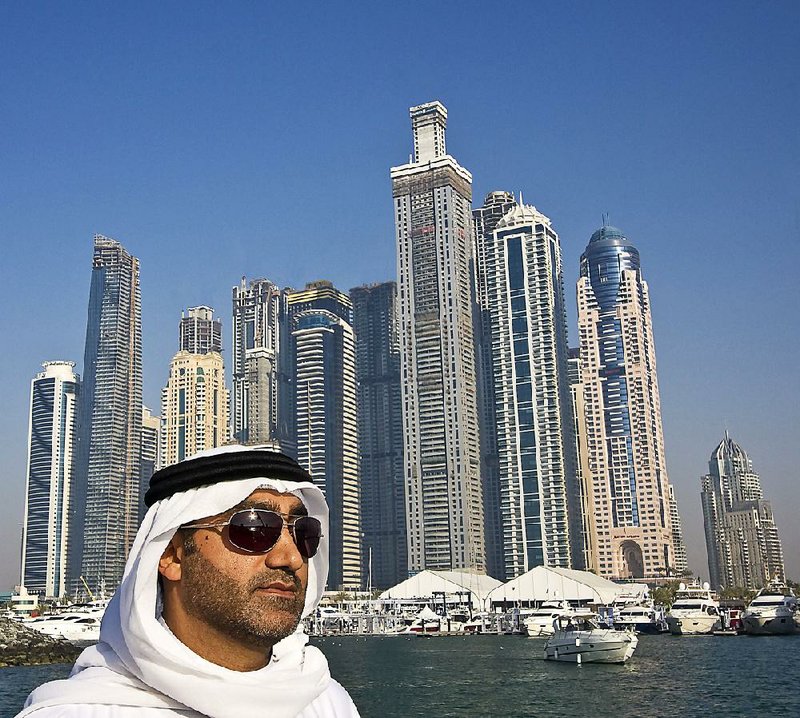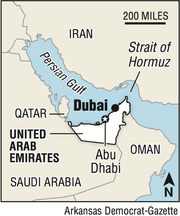DUBAI, United Arab Emirates -- Think Las Vegas without the sin, Disney without the mouse. Dubai, one of the seven Emirates (like a state) of the United Arab Emirates, is just a bit bigger than reality.
Actually, most everything here is "the biggest." There's the world's tallest building, the world's largest natural flower garden, among the world's biggest shopping malls and, for $6,800, the world's most deluxe spa experience, which includes a 24-carat-gold facial. Plus, soon to come -- the world's biggest Ferris wheel. And also on the way, a 68-story, wind-and-solar-powered building whose individual floors will rotate so that the actual tower will seem to writhe before your eyes.
Yet, none of this existed 40 years ago.
And, yikes, it's still growing.
So think of Dubai as a trip into the future, but also into the past.
Amid the glass and steel spires are people who remember living in goatskin tents with rugs on sand floors.
The modern city of Dubai gleams and sparkles with buildings of glass and steel that soar, lean, bulge, twist and fold, often seeming to defy gravity.
It looks like all those pictures from the New York World's Fair of 1964 that showed cities of the future. All that's missing are the jet packs and hovercraft.
It's not a walking city. You really need wheels to get from here to there, and the "here to there" stretches for 40 miles.
But there's also the desert, the camels, the henna tattoos, the hookahs, the culture. Scratch the surface and the past is not far beneath.
What makes Dubai more visitor-friendly than many places in the Middle East is the fact that around 90 percent of the population of more than 2 million is not Emirati. A huge number of those who live here are corporate types who work in those glass spires and live well. There are also numerous non-Emiratis who work building those spires.
So Dubai has learned to be somewhat more open to foreign ideas and more welcoming.
All of which starts with the Sheikh Mohammed Centre for Cultural Understanding, which is an absolute "must" visit.
"There is no such thing as an embarrassing, offensive or stupid question," said Khulood Atryat, a stunningly beautiful woman who led the question-and-answer sessions when I was in Dubai a few years ago.
"There were many misconceptions on both sides," Atryat continued. "Outsiders thought we were all religious fanatics and that our women were virtual prisoners. We thought outsiders were just here to make money, take our money, disregard our culture and leave."
Inevitably our group wound up talking about dress. Of all the colors, in the hottest country, why do women wear black? Well, for reasons rooted in history. Black cloth "was the cheapest and the most convenient in the day," Atryat said. It made women invisible for travel at night. It also completely concealed them by day, which, trust me, the white men's robes do not. And it didn't show dirt.
"Abaya," by the way, means shield. It is the robe many women wear. But today, it is often a fashion statement, covered with crystals and gems by the rich to wear to parties and special events.
My most recent visit to the center brought Nasif and his keen sense of humor.
Someone asked if there is a set age when boys can begin wearing robes.
Nasif sighed.
"My wife went out and bought one for our infant son. It cost more than mine!"
Then he led us through the center's re-creation of a village, explaining that narrow alleys not only provide shade but funnel cooling breezes. And he explained what was found near Dubai's location at the edge of the Arabian Gulf -- pearls.
"Africa has diamonds and gold but we had pearls," he said.
Lacking the oil resources of its Middle Eastern neighbors, pearl diving, fishing, camel herding and trading were Dubai's chief sources of income.
Dubai is still a crossroads. Today, some 1,800 cargo ships dock there each month.
Which brings us to the commercial side of Dubai -- the malls. There's the Mall of the Emirates with its 285-foot-high mountain with five ski runs and penguins. But for total wow, you can't miss Dubai Mall, with 1,200 shops and 6 million square feet of, well, you name it, along with 65 million (yes, million) visitors a year.
Start with the 80-foot-long dinosaur skeleton at one of the entrances, then continue on to the four-story-tall waterfall and the amusement park where kids can choose an occupation (doctor, airline pilot, teacher, policeman), dress accordingly and try their little hands at it.
But it was the aquarium that brought me to a standstill. It has (of course) one of the world's largest acrylic viewing panels, along with a shark tunnel. But mostly, it has more fish than I've ever seen in one place -- huge schools of this and that, threading around manta rays, giant groupers, sharks and the occasional diver.
Yes, you can scuba dive the Dubai Mall aquarium. You need proper dive certification, of course. And had I known in advance, I would have been first in line, dive card in hand.
All this was fun, but the highlight of my trip was the desert safari.
OK, it's a tourist thing but it's still exotic, a peek at traditional Bedouin life and a total giggle.
My two friends and I were picked up at our hotel in a four-wheel-drive SUV for the hour drive into the dunes. Along the way, a procession of camels crossed our path, probably 100 of them, loping down the street, heading for race training.
Several had a small box atop the saddle. Camels can't race carrying a lot of weight, so in past years, they were guided by young children in the saddles, sometimes with catastrophic results. Laws were passed, robots invented and today, the camels race with radio-controlled machines that weigh around 5 pounds.
We stopped briefly at a camel camp with adorable baby camels as guide Yasir Ali explained a bit about camel farming and added, casually, "Here camels have more value than humans."
Then off to the dune bashing, an experience not for the faint of stomach. "I am quite experienced in this," Ali said as we careened up, over and down the dunes, often sideways, while he seemed to defy the laws of physics with the car.
Sunset was glorious as a blood-red ball slid behind the dunes. And then we were at the camp, a collection of divided cloth tents with pillows for seating and rugs for floors. We were greeted with rose water to wash our hands and Arabic coffee to perk us up, then off to try a hookah.
The hookah, an instrument for vaporizing and smoking flavored tobacco where the vapor is passed through a water basin, is ubiquitous in the Middle East. We encountered it everywhere, including on the swimming pool deck of several very upper-class hotels.
And of course, I had to give it a go. But you can't blow the smoke out of your mouth unless you inhale and produce bubbles in the device, no matter how hard you suck on it. My friends have a great shot of me turning purple and coughing my head off. So much for my smoking experiment.
Later that evening, we got henna tattoos and a chance to ride a camel. The most exciting part is when the beast rocks forward, then backward to stand, a motion that feels like it's becoming some kid's transformer toy under your rump.
As for the henna, for $5 I had an intricate design dribbled onto my hand. You leave the black mud on for 30 minutes, then scrape it off. To my disappointment, it left behind a barely visible, light orange design. But by the next morning, it had turned into a deep terra cotta that lasted for more than a week.
And then came the high point of the night, Larissa the belly dancer, whose hips took on a life of their own as she twirled with scarf and knife in the dim light, much to the appreciation of a line of local men in their robes.
There was more in our trip. We indulged in a spa treatment, and tried bicycle riding on the manmade Palm Island with its ultra deluxe hotels and an oddly Caribbean feel. And on one of our last nights, we attended the Dubai World Cup.
It's not soccer but, rather, horse racing with a $10 million purse (yes, the world's richest) and everyone dressed to the nines. There is even a published pamphlet on how to dress (think Wimbledon) with expensive suits, fancy dresses and extravagant Kate Middleton hats. The marching band is dressed in Arab robes; there's fireworks, food, booze.
It is, in other words, Dubai's top party of the year.
What did we miss in Dubai?
Quite a lot.
There are tours where you can learn calligraphy and traditional dances, meet a local artist and paint with him, visit farms, prepare and share a meal with a fisherman, visit private homes. There are themed hotels like in Las Vegas. There are places with swimming pools the size of small villages.
In the end, five days was just not enough.
Travel on 09/07/2014

